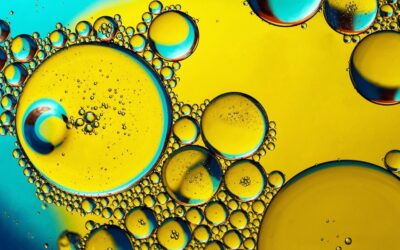Welcome to the latest selection of recent top articles in the physica status solidi journals. Get a glimpse of our publication spectrum and visit our pages by clicking on any of the DOI links below.
Evidence of two-photon absorption in strain-free quantum dot GaAs/AlGaAs solar cells [Rapid Research Letter]
Andrea Scaccabarozzi, Silvia Adorno, Sergio Bietti, Maurizio Acciarri, and Stefano Sanguinetti
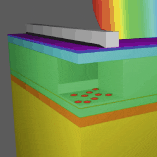 An intermediate band solar cell containing high-density, strain-free quantum dots grown by droplet epitaxy is demonstrated to produce photocurrent when two sub-bandgap energy photons are absorbed simultaneously. The quality of the quantum dot/barrier pair – allowed by the absence of strain-related defects, the good confinement, and the capability of droplet epitaxy to grow high-density and large aspect ratio quantum dots – opens new opportunities for quantum dot based solar cells.
An intermediate band solar cell containing high-density, strain-free quantum dots grown by droplet epitaxy is demonstrated to produce photocurrent when two sub-bandgap energy photons are absorbed simultaneously. The quality of the quantum dot/barrier pair – allowed by the absence of strain-related defects, the good confinement, and the capability of droplet epitaxy to grow high-density and large aspect ratio quantum dots – opens new opportunities for quantum dot based solar cells.
Phys. Status Solidi RRL(2013) DOI 10.1002/pssr.201206518
Dual behavior of excess electrons in rutile TiO2 [Rapid Research Letter]
A. Janotti, C. Franchini, J. B. Varley, G. Kresse, and C. G. Van de Walle
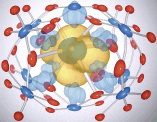 First-principles calculations reveal that localized small polarons and delocalized free electrons coexist in TiO2, with polarons being slightly lower in energy. This explains why electronic transport measurements probe mobile, delocalized free electrons, while optical absorption spectra provide signatures of small polarons. Binding of polarons to shallow donors such as oxygen vacancies explains the rich spectrum of Ti3+ species observed in electron spin resonance experiments.
First-principles calculations reveal that localized small polarons and delocalized free electrons coexist in TiO2, with polarons being slightly lower in energy. This explains why electronic transport measurements probe mobile, delocalized free electrons, while optical absorption spectra provide signatures of small polarons. Binding of polarons to shallow donors such as oxygen vacancies explains the rich spectrum of Ti3+ species observed in electron spin resonance experiments.
Phys. Status Solidi RRL(2013) DOI 10.1002/pssr.201206464
Improved efficiency of blue phosphorescence organic light-emitting diodes with irregular stepwise-doping emitting layers [Editor’s Choice]
Jun Liu, Jing Wang, Saijun Huang, Hsi-An Chen, and Gufeng He
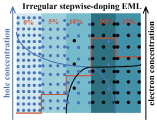 A stepwise-doping emitting layer is considered as an effective way to control the charge transport and recombination in organic light-emitting diodes (OLEDs). It has been demonstrated that the irregular stepwise doping profile in the emitting layer can deliver better charge carrier balance and tune the recombination zone away from the low triplet energy electron transporting layer to avoid possible quenching. Both effects improve the efficiency significantly. It is anticipated that this method can also be applied to other emitting systems to realize better performance.
A stepwise-doping emitting layer is considered as an effective way to control the charge transport and recombination in organic light-emitting diodes (OLEDs). It has been demonstrated that the irregular stepwise doping profile in the emitting layer can deliver better charge carrier balance and tune the recombination zone away from the low triplet energy electron transporting layer to avoid possible quenching. Both effects improve the efficiency significantly. It is anticipated that this method can also be applied to other emitting systems to realize better performance.
Phys. Status Solidi A(2013) DOI 10.1002/pssa.201228727
Hierarchically porous cobalt oxyhydroxide derived from Morpho butterfly wings: preparation, characterization and carbon monoxide detection at low temperatures [Original Paper]
Jian-Wen Wang and Yi-Ming Kuo
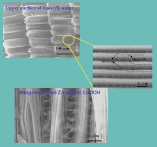 Hierarchical porous cobalt oxyhydroxide (CoOOH) has been successfully synthesized using Morpho butterfly wings as template via a sol–gel dip-coating process followed by hydrothermal approach. The biomorphic CoOOH replicas exhibit similar grain size, well-organized porous frameworks, and similar BET surface area and porosity, despite the different wall thicknesses (estimated to be about 40–50 nm for wing-templated Zn-doped CoOOH). An improvement in the CO sensitivity and ultimately in selectivity of CO sensors based on CoOOH can be achieved by providing wing-templated Zn-doped CoOOH films. The bioinspired method and the enhanced properties derived from the unique hierarchical architecture are of great significance in the synthesis and applications of sensing materials.
Hierarchical porous cobalt oxyhydroxide (CoOOH) has been successfully synthesized using Morpho butterfly wings as template via a sol–gel dip-coating process followed by hydrothermal approach. The biomorphic CoOOH replicas exhibit similar grain size, well-organized porous frameworks, and similar BET surface area and porosity, despite the different wall thicknesses (estimated to be about 40–50 nm for wing-templated Zn-doped CoOOH). An improvement in the CO sensitivity and ultimately in selectivity of CO sensors based on CoOOH can be achieved by providing wing-templated Zn-doped CoOOH films. The bioinspired method and the enhanced properties derived from the unique hierarchical architecture are of great significance in the synthesis and applications of sensing materials.
Phys. Status Solidi A(2012) DOI 10.1002/pssa.201228587
Neural network potentials for metals and oxides – First applications to copper clusters at zinc oxide [Feature Article]
Nongnuch Artrith, Björn Hiller, and Jörg Behler
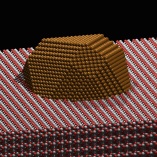 The development of reliable interatomic potentials for large-scale molecular dynamics simulations of chemical processes at surfaces and interfaces is a formidable challenge because a wide range of atomic environments and very different types of bonding can be present. In recent years interatomic potentials based on artificial neural networks (NN) have emerged, offering an unbiased approach to the construction of potential energy surfaces for systems that are difficult to describe by conventional potentials. Artrith et al. review the basic properties of NN potentials and describe their construction for materials like metals and oxides. The accuracy and efficiency are demonstrated using copper and zinc oxide as benchmark systems. First results for a potential of the combined ternary CuZnO system aiming at the description of oxide-supported copper clusters are reported.
The development of reliable interatomic potentials for large-scale molecular dynamics simulations of chemical processes at surfaces and interfaces is a formidable challenge because a wide range of atomic environments and very different types of bonding can be present. In recent years interatomic potentials based on artificial neural networks (NN) have emerged, offering an unbiased approach to the construction of potential energy surfaces for systems that are difficult to describe by conventional potentials. Artrith et al. review the basic properties of NN potentials and describe their construction for materials like metals and oxides. The accuracy and efficiency are demonstrated using copper and zinc oxide as benchmark systems. First results for a potential of the combined ternary CuZnO system aiming at the description of oxide-supported copper clusters are reported.
Phys. Status Solidi B(2012) DOI 10.1002/pssr.201248370
Symmetry breaking and low energy conformational fluctuations in amorphous graphene [Original Paper]
Y. Li and D. A. Drabold
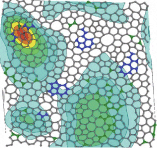 Amorphous graphene has a rich and interesting energy landscape. A distinct energy scale of basins (∼10 meV) is observed, associated with different puckered configurations – and then within such a configuration, an ambiguous energy minimum with a continuum of bond angles and bond lengths with an energy scale of few μeV and a nearly flat potential-energy landscape. Within a given puckered configuration, this continuum is much like what was seen for a-Si:H earlier. Vibrational calculations reveal the existence of localized imaginary-frequency modes in a flat 800-atom amorphous graphene model. These modes are localized on pentagons and play the key role in losing planar symmetry and forming pentagonal puckering structures.
Amorphous graphene has a rich and interesting energy landscape. A distinct energy scale of basins (∼10 meV) is observed, associated with different puckered configurations – and then within such a configuration, an ambiguous energy minimum with a continuum of bond angles and bond lengths with an energy scale of few μeV and a nearly flat potential-energy landscape. Within a given puckered configuration, this continuum is much like what was seen for a-Si:H earlier. Vibrational calculations reveal the existence of localized imaginary-frequency modes in a flat 800-atom amorphous graphene model. These modes are localized on pentagons and play the key role in losing planar symmetry and forming pentagonal puckering structures.
Phys. Status Solidi B(2012) DOI 10.1002/pssb.201248481













